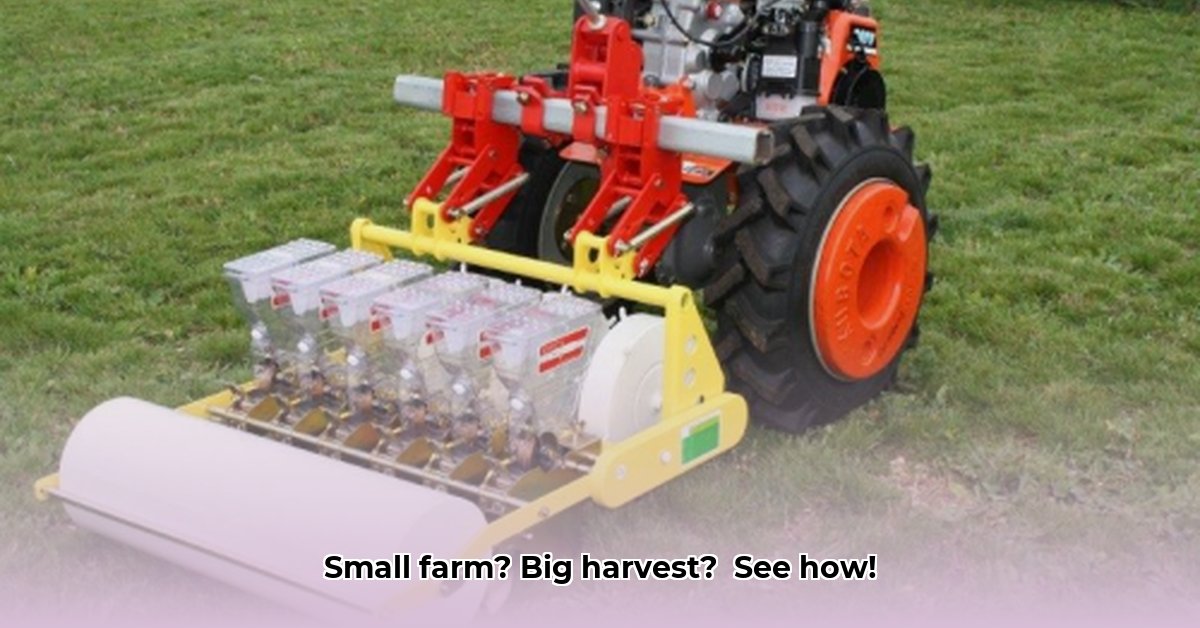
Seeder Tractor Selection: Maximizing Your Small Farm Harvest
Choosing the right seeder tractor is a pivotal decision for small-scale farmers aiming for increased yields, reduced labor, and environmentally friendly practices. This guide provides a comprehensive overview of tow-behind seeders, helping you navigate the market and select the ideal model for your specific needs. We’ll explore various seeder types, offer practical advice, and highlight the sustainability benefits. For smaller farms, consider compact tractor attachments.
Understanding Your Farming Needs: A Farmer's Perspective
Before examining specific seeder models, a thorough assessment of your farm’s unique characteristics is crucial. Consider these key questions:
- Farm size: Acreage significantly influences seeder size and capacity. Smaller farms (under 10 acres) benefit from compact models; larger operations may require heavier-duty equipment.
- Crop type: Different crops necessitate specific planting methods. Row crops (vegetables, grains) require precision seeders, while cover crops or forage may utilize broadcast seeders.
- Budget: Seeders range in price, impacting your initial investment and long-term cost-effectiveness. Factor in maintenance, repairs, and potential financing options.
- Precision Needs: High-precision planting (perfectly spaced rows) improves yield and reduces seed waste. GPS-guided seeders offer superior accuracy but come with a higher price tag.
- Sustainability Goals: Prioritizing environmentally friendly practices favors no-till seeders, minimizing soil disruption and promoting soil health.
"Investing in the right equipment is a long-term commitment. A durable and efficient seeder will pay off in terms of increased yields, reduced labor, and a lower environmental impact," states Sarah Miller, a sustainable farming expert with 15 years of experience at the Organic Growers Association.
Types of Tow-Behind Seeders: A Comprehensive Overview
Several seeder types cater to diverse farming needs:
- Broadcast Seeders: These scatter seeds over a wide area, ideal for cover crops or forage on smaller fields. They are inexpensive but lack precision.
- Row Seeders: Offering precise seed placement, row seeders excel with row crops, optimizing yields. They typically cost more than broadcast seeders but offer greater efficiency.
- No-Till Seeders: Designed for minimal soil disturbance, these environmentally-friendly seeders promote healthier soil structure, reduce erosion, and enhance water infiltration. They generally represent a higher initial investment.
The optimal seeder type depends on your farming practices, budgetary constraints, and environmental priorities. Each offers unique advantages and drawbacks, requiring careful consideration.
Matching Seeder to Tractor: Ensuring Compatibility
Proper seeder-tractor compatibility is critical. Ensure your tractor possesses sufficient PTO (Power Take-Off) horsepower and drawbar pull—the tractor’s capacity to pull weight without strain. Consult your tractor's manual to prevent damage and ensure optimal performance. Using an oversized seeder can overtax your tractor, potentially causing mechanical issues.
Choosing Your Seeder: A Decision-Making Framework
The following table simplifies the decision-making process:
| Factor | Considerations |
|---|---|
| Farm Size | Smaller farms (<10 acres): Compact broadcast or row seeders. Larger farms: Larger, more powerful models. |
| Crop Type | Seed type and planting depth influence seeder choice; some seeders are better suited to specific crops. |
| Budget | Seeders vary widely in price; consider long-term costs (maintenance, repairs) and financing options. |
| Precision Needs | High-precision planting? Evaluate GPS-guided seeders for superior accuracy, accepting a higher price point. |
| Sustainability | Eco-friendly focus? Opt for no-till seeders to minimize soil disruption and promote healthy soil structure. |
Practical Tips & Maintenance: Maximizing Seeder Lifespan
Regular maintenance is crucial for optimal seeder performance and longevity:
- Pre-Season Inspection: Before planting, meticulously inspect all parts, ensuring proper seed flow and functionality.
- Calibration: Accurate seed distribution is paramount. Calibrate regularly according to manufacturer instructions.
- Post-Use Cleaning: Thoroughly clean the seeder after each use to remove dirt, debris, and leftover seeds.
- Proper Storage: Store the seeder in a dry, clean location during the off-season to prevent damage and rust.
Sustainability and the Future: Environmental Considerations
Sustainable farming practices are increasingly important. No-till seeders exemplify environmentally responsible technology by reducing fuel consumption, minimizing soil erosion, and improving soil health. Ongoing research focuses on enhancing precision, lowering fuel consumption, and utilizing more sustainable materials in construction. The future of seeder technology points towards increased efficiency and reduced environmental impact.
Conclusion: Investing in Sustainable Farming Practices
Selecting the right seed tractor is a significant investment, directly impacting your farm's success and efficiency. Carefully evaluating your individual needs, budget, and sustainability goals is essential. By choosing a durable and efficient seeder, you'll optimize your harvest, minimize labor, and contribute to environmentally friendly farming practices. The long-term benefits far outweigh the initial investment, paving the way for a thriving and sustainable agricultural future.